IS Services within Telstra: Control of Information Security Services
VerifiedAdded on 2023/06/09
|12
|3105
|495
AI Summary
This report discusses the control of information security services within Telstra, covering the GMCs and ACs of Telstra, risk management techniques, and the importance of auditing IS within Telstra.
Contribute Materials
Your contribution can guide someone’s learning journey. Share your
documents today.
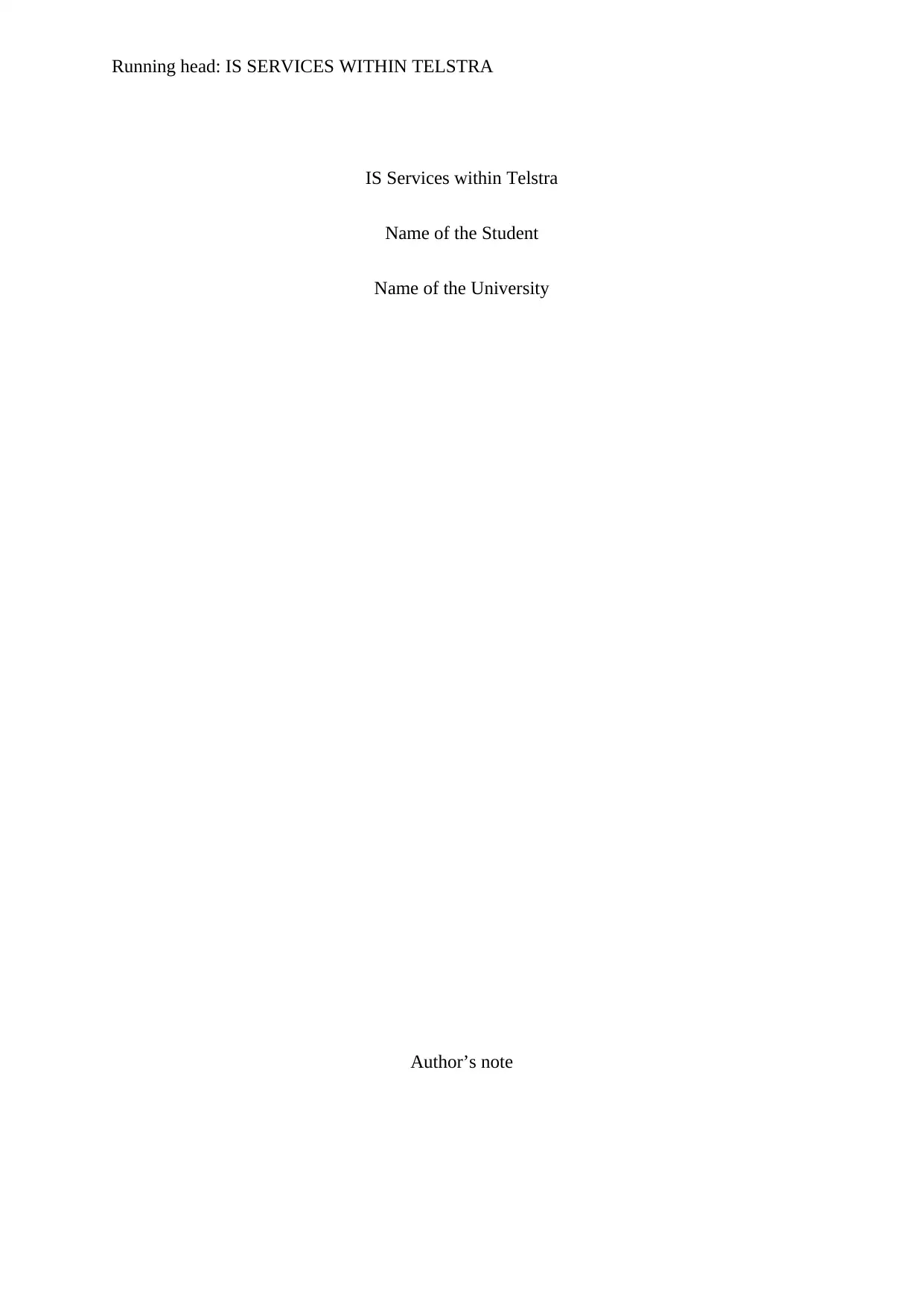
Running head: IS SERVICES WITHIN TELSTRA
IS Services within Telstra
Name of the Student
Name of the University
Author’s note
IS Services within Telstra
Name of the Student
Name of the University
Author’s note
Secure Best Marks with AI Grader
Need help grading? Try our AI Grader for instant feedback on your assignments.
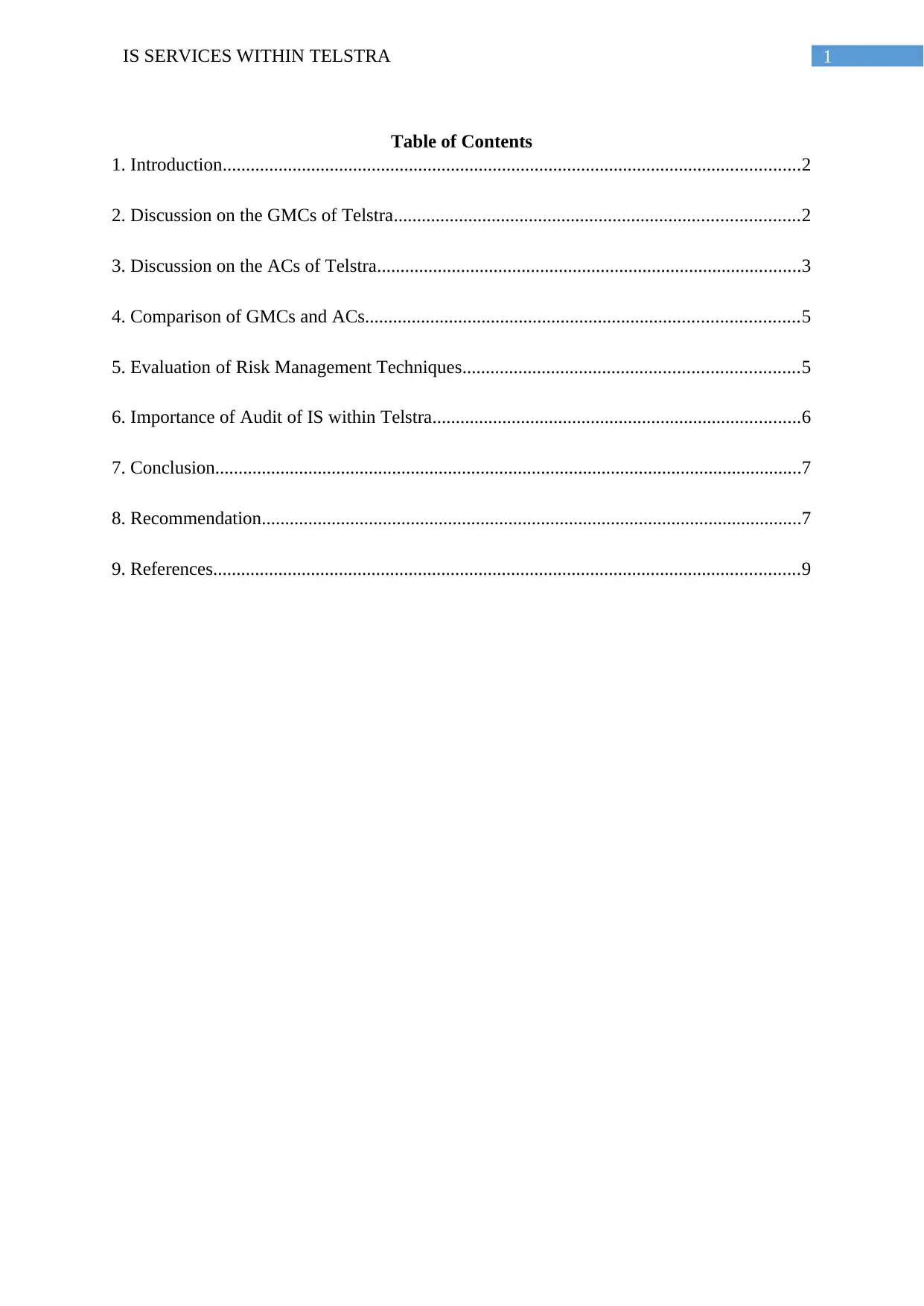
1IS SERVICES WITHIN TELSTRA
Table of Contents
1. Introduction............................................................................................................................2
2. Discussion on the GMCs of Telstra.......................................................................................2
3. Discussion on the ACs of Telstra...........................................................................................3
4. Comparison of GMCs and ACs.............................................................................................5
5. Evaluation of Risk Management Techniques........................................................................5
6. Importance of Audit of IS within Telstra...............................................................................6
7. Conclusion..............................................................................................................................7
8. Recommendation....................................................................................................................7
9. References..............................................................................................................................9
Table of Contents
1. Introduction............................................................................................................................2
2. Discussion on the GMCs of Telstra.......................................................................................2
3. Discussion on the ACs of Telstra...........................................................................................3
4. Comparison of GMCs and ACs.............................................................................................5
5. Evaluation of Risk Management Techniques........................................................................5
6. Importance of Audit of IS within Telstra...............................................................................6
7. Conclusion..............................................................................................................................7
8. Recommendation....................................................................................................................7
9. References..............................................................................................................................9
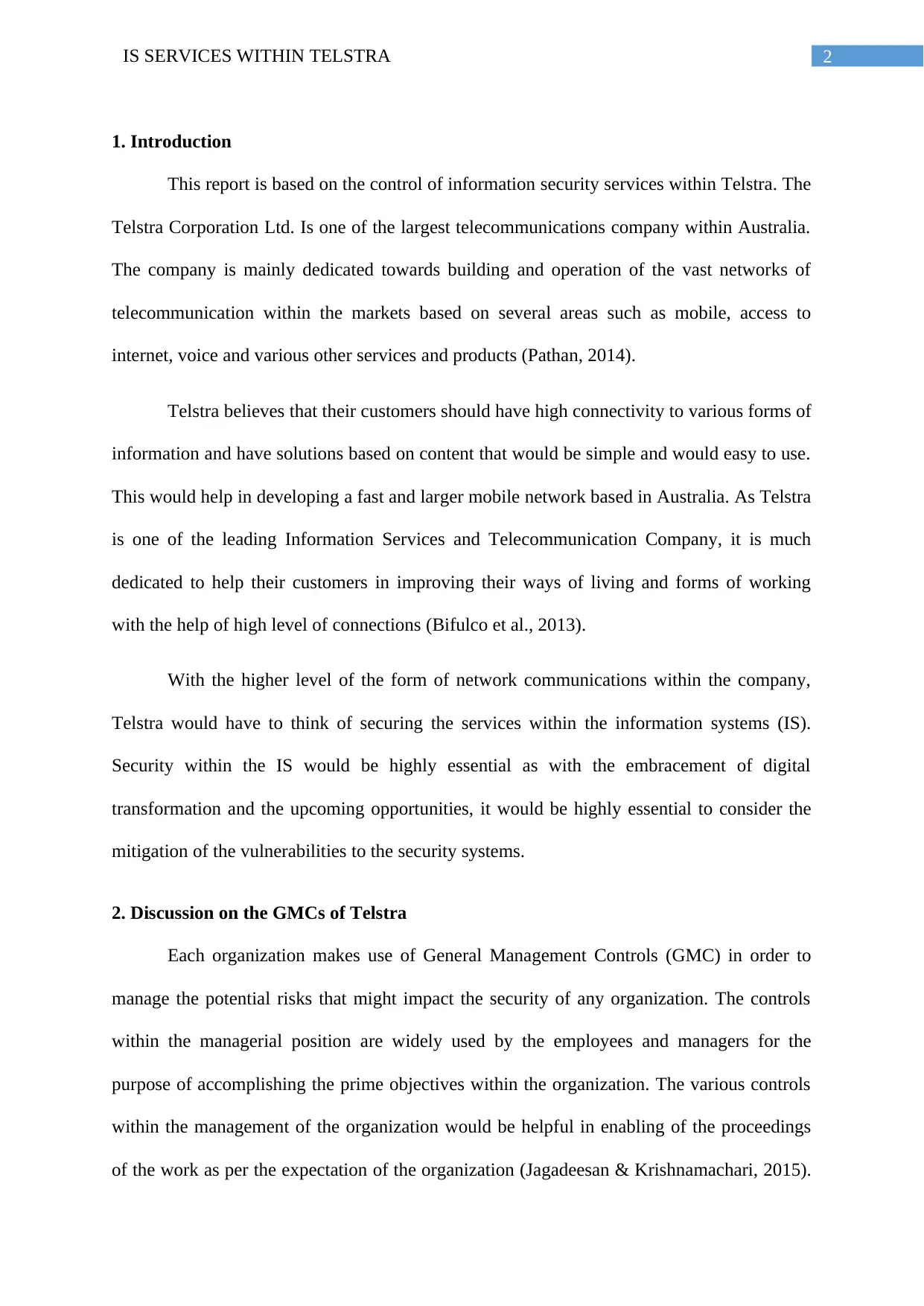
2IS SERVICES WITHIN TELSTRA
1. Introduction
This report is based on the control of information security services within Telstra. The
Telstra Corporation Ltd. Is one of the largest telecommunications company within Australia.
The company is mainly dedicated towards building and operation of the vast networks of
telecommunication within the markets based on several areas such as mobile, access to
internet, voice and various other services and products (Pathan, 2014).
Telstra believes that their customers should have high connectivity to various forms of
information and have solutions based on content that would be simple and would easy to use.
This would help in developing a fast and larger mobile network based in Australia. As Telstra
is one of the leading Information Services and Telecommunication Company, it is much
dedicated to help their customers in improving their ways of living and forms of working
with the help of high level of connections (Bifulco et al., 2013).
With the higher level of the form of network communications within the company,
Telstra would have to think of securing the services within the information systems (IS).
Security within the IS would be highly essential as with the embracement of digital
transformation and the upcoming opportunities, it would be highly essential to consider the
mitigation of the vulnerabilities to the security systems.
2. Discussion on the GMCs of Telstra
Each organization makes use of General Management Controls (GMC) in order to
manage the potential risks that might impact the security of any organization. The controls
within the managerial position are widely used by the employees and managers for the
purpose of accomplishing the prime objectives within the organization. The various controls
within the management of the organization would be helpful in enabling of the proceedings
of the work as per the expectation of the organization (Jagadeesan & Krishnamachari, 2015).
1. Introduction
This report is based on the control of information security services within Telstra. The
Telstra Corporation Ltd. Is one of the largest telecommunications company within Australia.
The company is mainly dedicated towards building and operation of the vast networks of
telecommunication within the markets based on several areas such as mobile, access to
internet, voice and various other services and products (Pathan, 2014).
Telstra believes that their customers should have high connectivity to various forms of
information and have solutions based on content that would be simple and would easy to use.
This would help in developing a fast and larger mobile network based in Australia. As Telstra
is one of the leading Information Services and Telecommunication Company, it is much
dedicated to help their customers in improving their ways of living and forms of working
with the help of high level of connections (Bifulco et al., 2013).
With the higher level of the form of network communications within the company,
Telstra would have to think of securing the services within the information systems (IS).
Security within the IS would be highly essential as with the embracement of digital
transformation and the upcoming opportunities, it would be highly essential to consider the
mitigation of the vulnerabilities to the security systems.
2. Discussion on the GMCs of Telstra
Each organization makes use of General Management Controls (GMC) in order to
manage the potential risks that might impact the security of any organization. The controls
within the managerial position are widely used by the employees and managers for the
purpose of accomplishing the prime objectives within the organization. The various controls
within the management of the organization would be helpful in enabling of the proceedings
of the work as per the expectation of the organization (Jagadeesan & Krishnamachari, 2015).
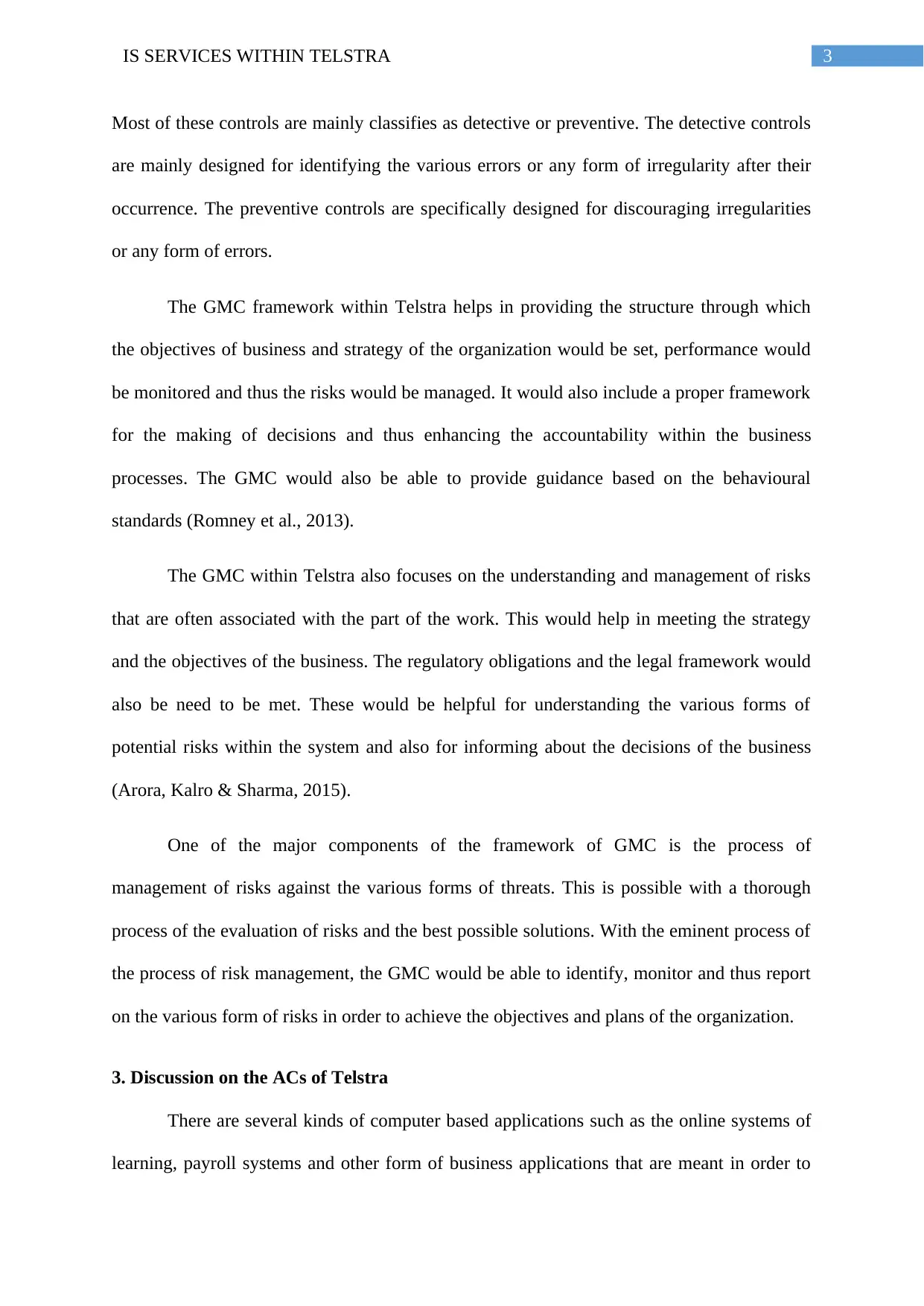
3IS SERVICES WITHIN TELSTRA
Most of these controls are mainly classifies as detective or preventive. The detective controls
are mainly designed for identifying the various errors or any form of irregularity after their
occurrence. The preventive controls are specifically designed for discouraging irregularities
or any form of errors.
The GMC framework within Telstra helps in providing the structure through which
the objectives of business and strategy of the organization would be set, performance would
be monitored and thus the risks would be managed. It would also include a proper framework
for the making of decisions and thus enhancing the accountability within the business
processes. The GMC would also be able to provide guidance based on the behavioural
standards (Romney et al., 2013).
The GMC within Telstra also focuses on the understanding and management of risks
that are often associated with the part of the work. This would help in meeting the strategy
and the objectives of the business. The regulatory obligations and the legal framework would
also be need to be met. These would be helpful for understanding the various forms of
potential risks within the system and also for informing about the decisions of the business
(Arora, Kalro & Sharma, 2015).
One of the major components of the framework of GMC is the process of
management of risks against the various forms of threats. This is possible with a thorough
process of the evaluation of risks and the best possible solutions. With the eminent process of
the process of risk management, the GMC would be able to identify, monitor and thus report
on the various form of risks in order to achieve the objectives and plans of the organization.
3. Discussion on the ACs of Telstra
There are several kinds of computer based applications such as the online systems of
learning, payroll systems and other form of business applications that are meant in order to
Most of these controls are mainly classifies as detective or preventive. The detective controls
are mainly designed for identifying the various errors or any form of irregularity after their
occurrence. The preventive controls are specifically designed for discouraging irregularities
or any form of errors.
The GMC framework within Telstra helps in providing the structure through which
the objectives of business and strategy of the organization would be set, performance would
be monitored and thus the risks would be managed. It would also include a proper framework
for the making of decisions and thus enhancing the accountability within the business
processes. The GMC would also be able to provide guidance based on the behavioural
standards (Romney et al., 2013).
The GMC within Telstra also focuses on the understanding and management of risks
that are often associated with the part of the work. This would help in meeting the strategy
and the objectives of the business. The regulatory obligations and the legal framework would
also be need to be met. These would be helpful for understanding the various forms of
potential risks within the system and also for informing about the decisions of the business
(Arora, Kalro & Sharma, 2015).
One of the major components of the framework of GMC is the process of
management of risks against the various forms of threats. This is possible with a thorough
process of the evaluation of risks and the best possible solutions. With the eminent process of
the process of risk management, the GMC would be able to identify, monitor and thus report
on the various form of risks in order to achieve the objectives and plans of the organization.
3. Discussion on the ACs of Telstra
There are several kinds of computer based applications such as the online systems of
learning, payroll systems and other form of business applications that are meant in order to
Secure Best Marks with AI Grader
Need help grading? Try our AI Grader for instant feedback on your assignments.
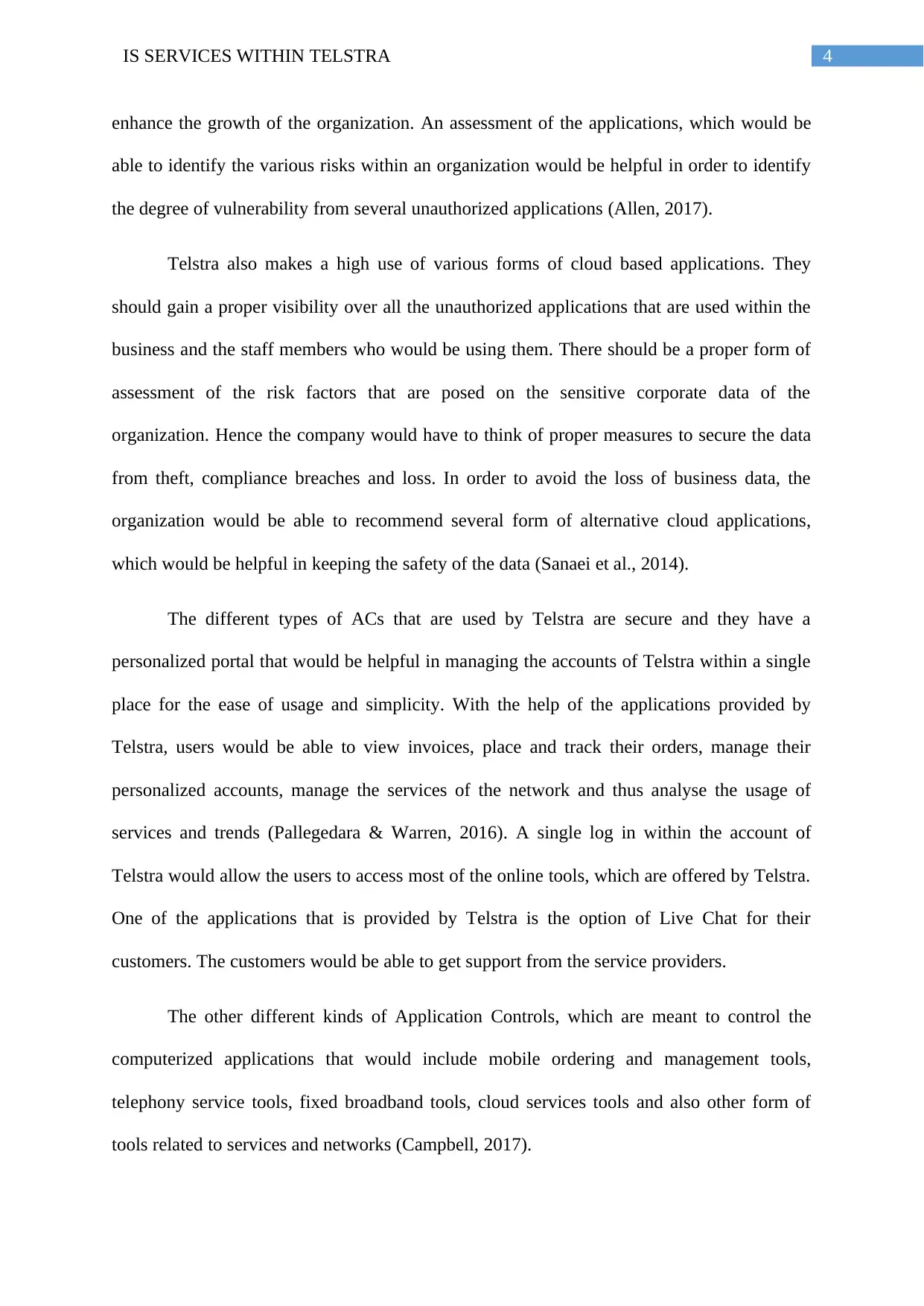
4IS SERVICES WITHIN TELSTRA
enhance the growth of the organization. An assessment of the applications, which would be
able to identify the various risks within an organization would be helpful in order to identify
the degree of vulnerability from several unauthorized applications (Allen, 2017).
Telstra also makes a high use of various forms of cloud based applications. They
should gain a proper visibility over all the unauthorized applications that are used within the
business and the staff members who would be using them. There should be a proper form of
assessment of the risk factors that are posed on the sensitive corporate data of the
organization. Hence the company would have to think of proper measures to secure the data
from theft, compliance breaches and loss. In order to avoid the loss of business data, the
organization would be able to recommend several form of alternative cloud applications,
which would be helpful in keeping the safety of the data (Sanaei et al., 2014).
The different types of ACs that are used by Telstra are secure and they have a
personalized portal that would be helpful in managing the accounts of Telstra within a single
place for the ease of usage and simplicity. With the help of the applications provided by
Telstra, users would be able to view invoices, place and track their orders, manage their
personalized accounts, manage the services of the network and thus analyse the usage of
services and trends (Pallegedara & Warren, 2016). A single log in within the account of
Telstra would allow the users to access most of the online tools, which are offered by Telstra.
One of the applications that is provided by Telstra is the option of Live Chat for their
customers. The customers would be able to get support from the service providers.
The other different kinds of Application Controls, which are meant to control the
computerized applications that would include mobile ordering and management tools,
telephony service tools, fixed broadband tools, cloud services tools and also other form of
tools related to services and networks (Campbell, 2017).
enhance the growth of the organization. An assessment of the applications, which would be
able to identify the various risks within an organization would be helpful in order to identify
the degree of vulnerability from several unauthorized applications (Allen, 2017).
Telstra also makes a high use of various forms of cloud based applications. They
should gain a proper visibility over all the unauthorized applications that are used within the
business and the staff members who would be using them. There should be a proper form of
assessment of the risk factors that are posed on the sensitive corporate data of the
organization. Hence the company would have to think of proper measures to secure the data
from theft, compliance breaches and loss. In order to avoid the loss of business data, the
organization would be able to recommend several form of alternative cloud applications,
which would be helpful in keeping the safety of the data (Sanaei et al., 2014).
The different types of ACs that are used by Telstra are secure and they have a
personalized portal that would be helpful in managing the accounts of Telstra within a single
place for the ease of usage and simplicity. With the help of the applications provided by
Telstra, users would be able to view invoices, place and track their orders, manage their
personalized accounts, manage the services of the network and thus analyse the usage of
services and trends (Pallegedara & Warren, 2016). A single log in within the account of
Telstra would allow the users to access most of the online tools, which are offered by Telstra.
One of the applications that is provided by Telstra is the option of Live Chat for their
customers. The customers would be able to get support from the service providers.
The other different kinds of Application Controls, which are meant to control the
computerized applications that would include mobile ordering and management tools,
telephony service tools, fixed broadband tools, cloud services tools and also other form of
tools related to services and networks (Campbell, 2017).
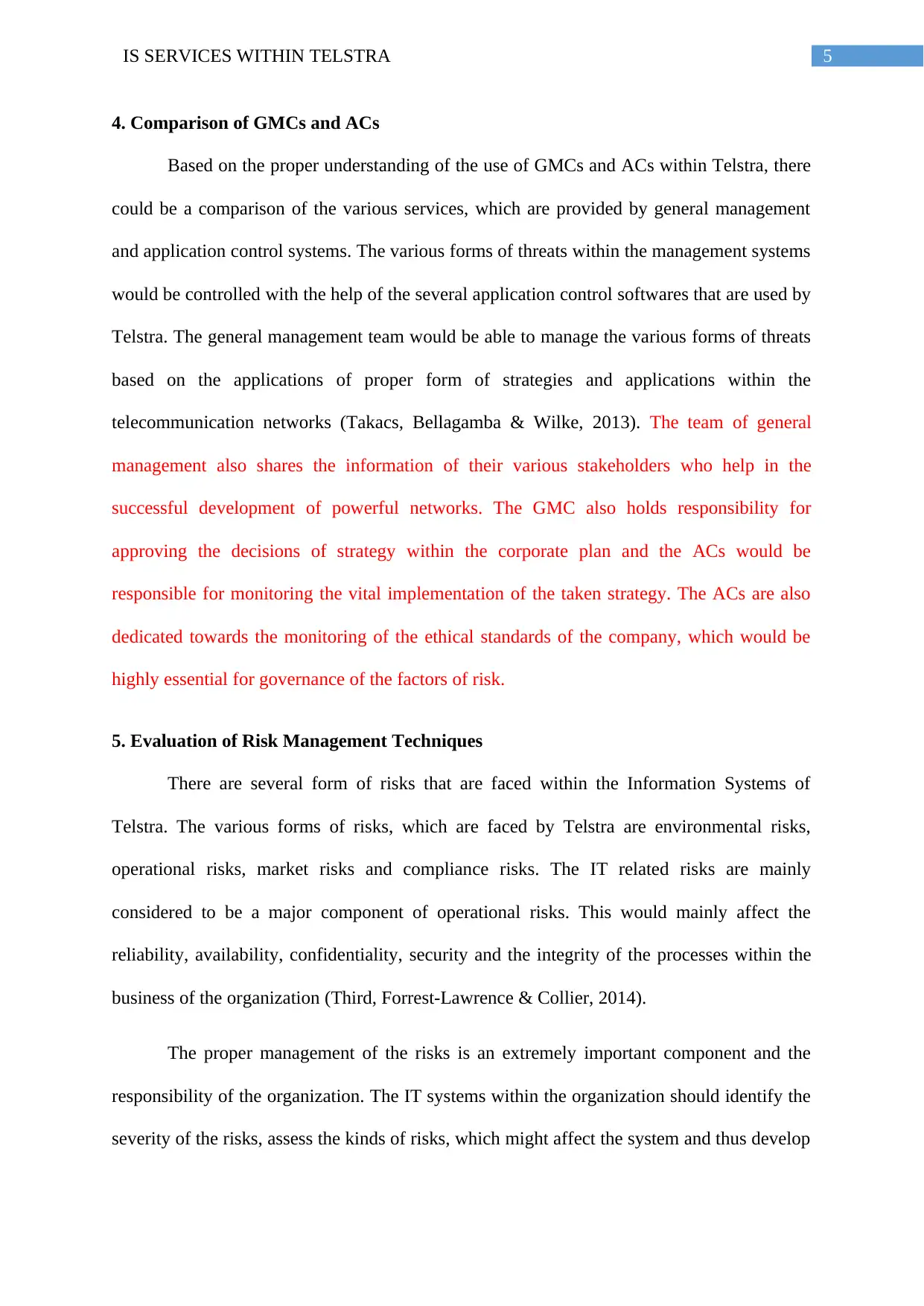
5IS SERVICES WITHIN TELSTRA
4. Comparison of GMCs and ACs
Based on the proper understanding of the use of GMCs and ACs within Telstra, there
could be a comparison of the various services, which are provided by general management
and application control systems. The various forms of threats within the management systems
would be controlled with the help of the several application control softwares that are used by
Telstra. The general management team would be able to manage the various forms of threats
based on the applications of proper form of strategies and applications within the
telecommunication networks (Takacs, Bellagamba & Wilke, 2013). The team of general
management also shares the information of their various stakeholders who help in the
successful development of powerful networks. The GMC also holds responsibility for
approving the decisions of strategy within the corporate plan and the ACs would be
responsible for monitoring the vital implementation of the taken strategy. The ACs are also
dedicated towards the monitoring of the ethical standards of the company, which would be
highly essential for governance of the factors of risk.
5. Evaluation of Risk Management Techniques
There are several form of risks that are faced within the Information Systems of
Telstra. The various forms of risks, which are faced by Telstra are environmental risks,
operational risks, market risks and compliance risks. The IT related risks are mainly
considered to be a major component of operational risks. This would mainly affect the
reliability, availability, confidentiality, security and the integrity of the processes within the
business of the organization (Third, Forrest-Lawrence & Collier, 2014).
The proper management of the risks is an extremely important component and the
responsibility of the organization. The IT systems within the organization should identify the
severity of the risks, assess the kinds of risks, which might affect the system and thus develop
4. Comparison of GMCs and ACs
Based on the proper understanding of the use of GMCs and ACs within Telstra, there
could be a comparison of the various services, which are provided by general management
and application control systems. The various forms of threats within the management systems
would be controlled with the help of the several application control softwares that are used by
Telstra. The general management team would be able to manage the various forms of threats
based on the applications of proper form of strategies and applications within the
telecommunication networks (Takacs, Bellagamba & Wilke, 2013). The team of general
management also shares the information of their various stakeholders who help in the
successful development of powerful networks. The GMC also holds responsibility for
approving the decisions of strategy within the corporate plan and the ACs would be
responsible for monitoring the vital implementation of the taken strategy. The ACs are also
dedicated towards the monitoring of the ethical standards of the company, which would be
highly essential for governance of the factors of risk.
5. Evaluation of Risk Management Techniques
There are several form of risks that are faced within the Information Systems of
Telstra. The various forms of risks, which are faced by Telstra are environmental risks,
operational risks, market risks and compliance risks. The IT related risks are mainly
considered to be a major component of operational risks. This would mainly affect the
reliability, availability, confidentiality, security and the integrity of the processes within the
business of the organization (Third, Forrest-Lawrence & Collier, 2014).
The proper management of the risks is an extremely important component and the
responsibility of the organization. The IT systems within the organization should identify the
severity of the risks, assess the kinds of risks, which might affect the system and thus develop
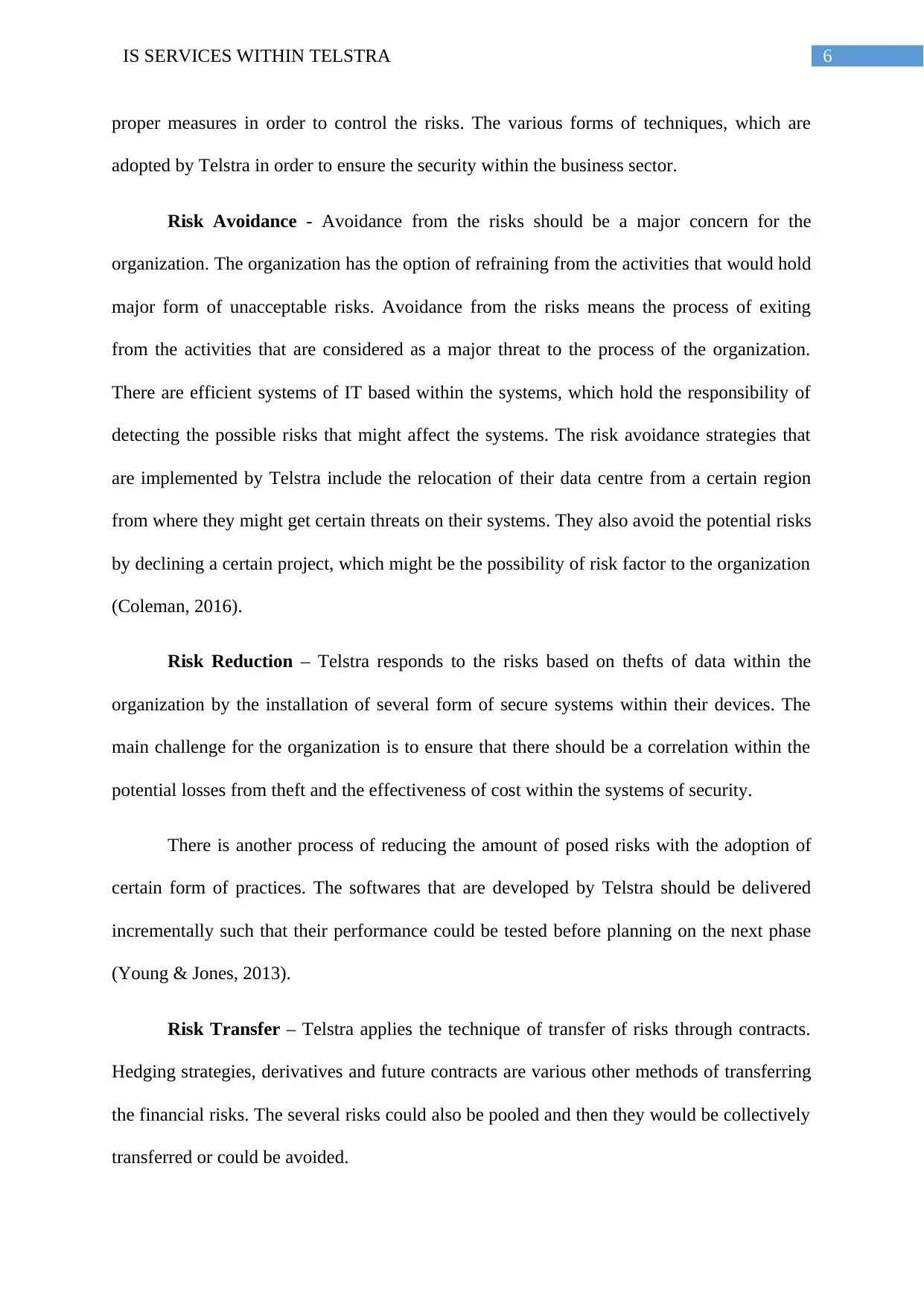
6IS SERVICES WITHIN TELSTRA
proper measures in order to control the risks. The various forms of techniques, which are
adopted by Telstra in order to ensure the security within the business sector.
Risk Avoidance - Avoidance from the risks should be a major concern for the
organization. The organization has the option of refraining from the activities that would hold
major form of unacceptable risks. Avoidance from the risks means the process of exiting
from the activities that are considered as a major threat to the process of the organization.
There are efficient systems of IT based within the systems, which hold the responsibility of
detecting the possible risks that might affect the systems. The risk avoidance strategies that
are implemented by Telstra include the relocation of their data centre from a certain region
from where they might get certain threats on their systems. They also avoid the potential risks
by declining a certain project, which might be the possibility of risk factor to the organization
(Coleman, 2016).
Risk Reduction – Telstra responds to the risks based on thefts of data within the
organization by the installation of several form of secure systems within their devices. The
main challenge for the organization is to ensure that there should be a correlation within the
potential losses from theft and the effectiveness of cost within the systems of security.
There is another process of reducing the amount of posed risks with the adoption of
certain form of practices. The softwares that are developed by Telstra should be delivered
incrementally such that their performance could be tested before planning on the next phase
(Young & Jones, 2013).
Risk Transfer – Telstra applies the technique of transfer of risks through contracts.
Hedging strategies, derivatives and future contracts are various other methods of transferring
the financial risks. The several risks could also be pooled and then they would be collectively
transferred or could be avoided.
proper measures in order to control the risks. The various forms of techniques, which are
adopted by Telstra in order to ensure the security within the business sector.
Risk Avoidance - Avoidance from the risks should be a major concern for the
organization. The organization has the option of refraining from the activities that would hold
major form of unacceptable risks. Avoidance from the risks means the process of exiting
from the activities that are considered as a major threat to the process of the organization.
There are efficient systems of IT based within the systems, which hold the responsibility of
detecting the possible risks that might affect the systems. The risk avoidance strategies that
are implemented by Telstra include the relocation of their data centre from a certain region
from where they might get certain threats on their systems. They also avoid the potential risks
by declining a certain project, which might be the possibility of risk factor to the organization
(Coleman, 2016).
Risk Reduction – Telstra responds to the risks based on thefts of data within the
organization by the installation of several form of secure systems within their devices. The
main challenge for the organization is to ensure that there should be a correlation within the
potential losses from theft and the effectiveness of cost within the systems of security.
There is another process of reducing the amount of posed risks with the adoption of
certain form of practices. The softwares that are developed by Telstra should be delivered
incrementally such that their performance could be tested before planning on the next phase
(Young & Jones, 2013).
Risk Transfer – Telstra applies the technique of transfer of risks through contracts.
Hedging strategies, derivatives and future contracts are various other methods of transferring
the financial risks. The several risks could also be pooled and then they would be collectively
transferred or could be avoided.
Paraphrase This Document
Need a fresh take? Get an instant paraphrase of this document with our AI Paraphraser
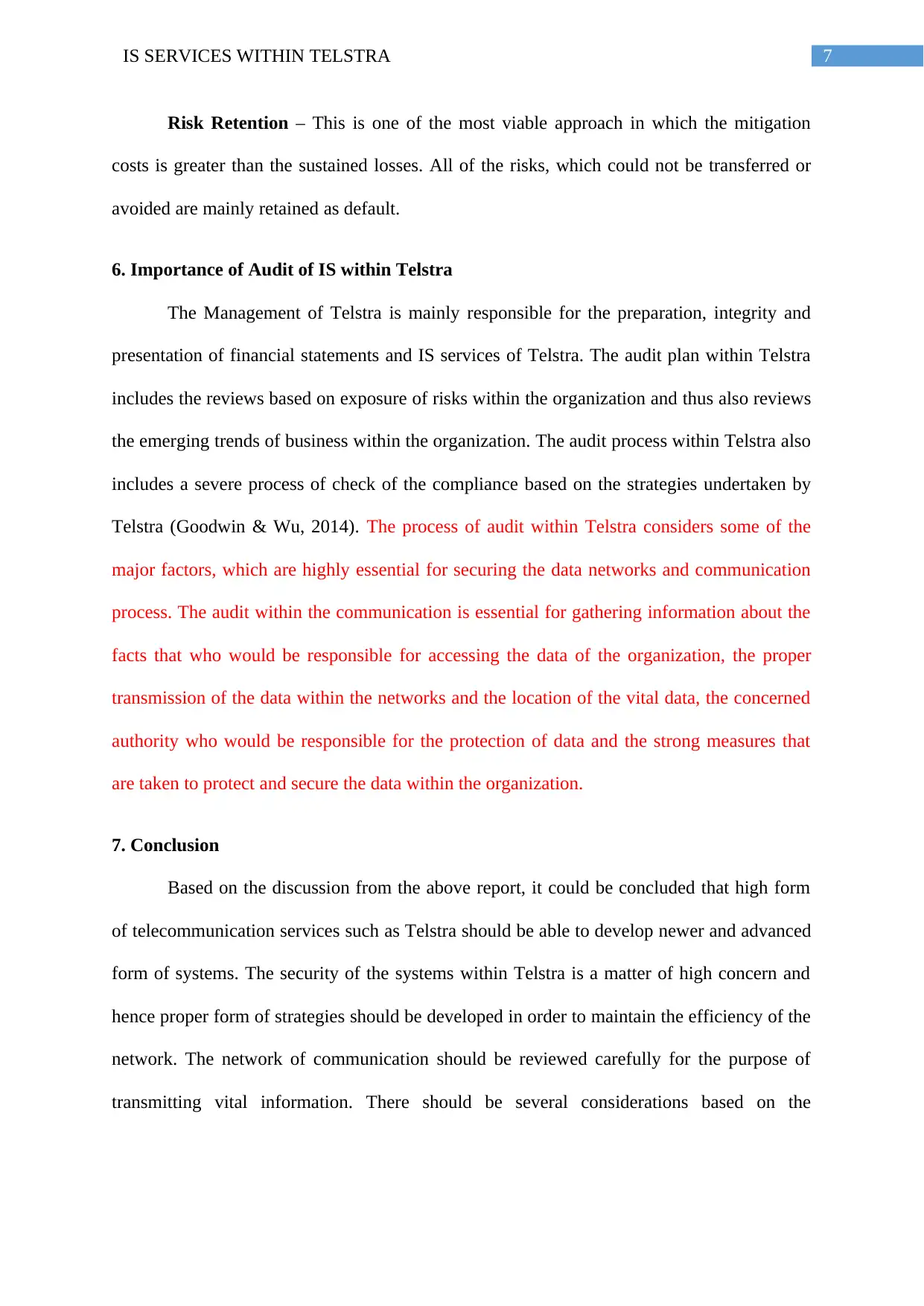
7IS SERVICES WITHIN TELSTRA
Risk Retention – This is one of the most viable approach in which the mitigation
costs is greater than the sustained losses. All of the risks, which could not be transferred or
avoided are mainly retained as default.
6. Importance of Audit of IS within Telstra
The Management of Telstra is mainly responsible for the preparation, integrity and
presentation of financial statements and IS services of Telstra. The audit plan within Telstra
includes the reviews based on exposure of risks within the organization and thus also reviews
the emerging trends of business within the organization. The audit process within Telstra also
includes a severe process of check of the compliance based on the strategies undertaken by
Telstra (Goodwin & Wu, 2014). The process of audit within Telstra considers some of the
major factors, which are highly essential for securing the data networks and communication
process. The audit within the communication is essential for gathering information about the
facts that who would be responsible for accessing the data of the organization, the proper
transmission of the data within the networks and the location of the vital data, the concerned
authority who would be responsible for the protection of data and the strong measures that
are taken to protect and secure the data within the organization.
7. Conclusion
Based on the discussion from the above report, it could be concluded that high form
of telecommunication services such as Telstra should be able to develop newer and advanced
form of systems. The security of the systems within Telstra is a matter of high concern and
hence proper form of strategies should be developed in order to maintain the efficiency of the
network. The network of communication should be reviewed carefully for the purpose of
transmitting vital information. There should be several considerations based on the
Risk Retention – This is one of the most viable approach in which the mitigation
costs is greater than the sustained losses. All of the risks, which could not be transferred or
avoided are mainly retained as default.
6. Importance of Audit of IS within Telstra
The Management of Telstra is mainly responsible for the preparation, integrity and
presentation of financial statements and IS services of Telstra. The audit plan within Telstra
includes the reviews based on exposure of risks within the organization and thus also reviews
the emerging trends of business within the organization. The audit process within Telstra also
includes a severe process of check of the compliance based on the strategies undertaken by
Telstra (Goodwin & Wu, 2014). The process of audit within Telstra considers some of the
major factors, which are highly essential for securing the data networks and communication
process. The audit within the communication is essential for gathering information about the
facts that who would be responsible for accessing the data of the organization, the proper
transmission of the data within the networks and the location of the vital data, the concerned
authority who would be responsible for the protection of data and the strong measures that
are taken to protect and secure the data within the organization.
7. Conclusion
Based on the discussion from the above report, it could be concluded that high form
of telecommunication services such as Telstra should be able to develop newer and advanced
form of systems. The security of the systems within Telstra is a matter of high concern and
hence proper form of strategies should be developed in order to maintain the efficiency of the
network. The network of communication should be reviewed carefully for the purpose of
transmitting vital information. There should be several considerations based on the
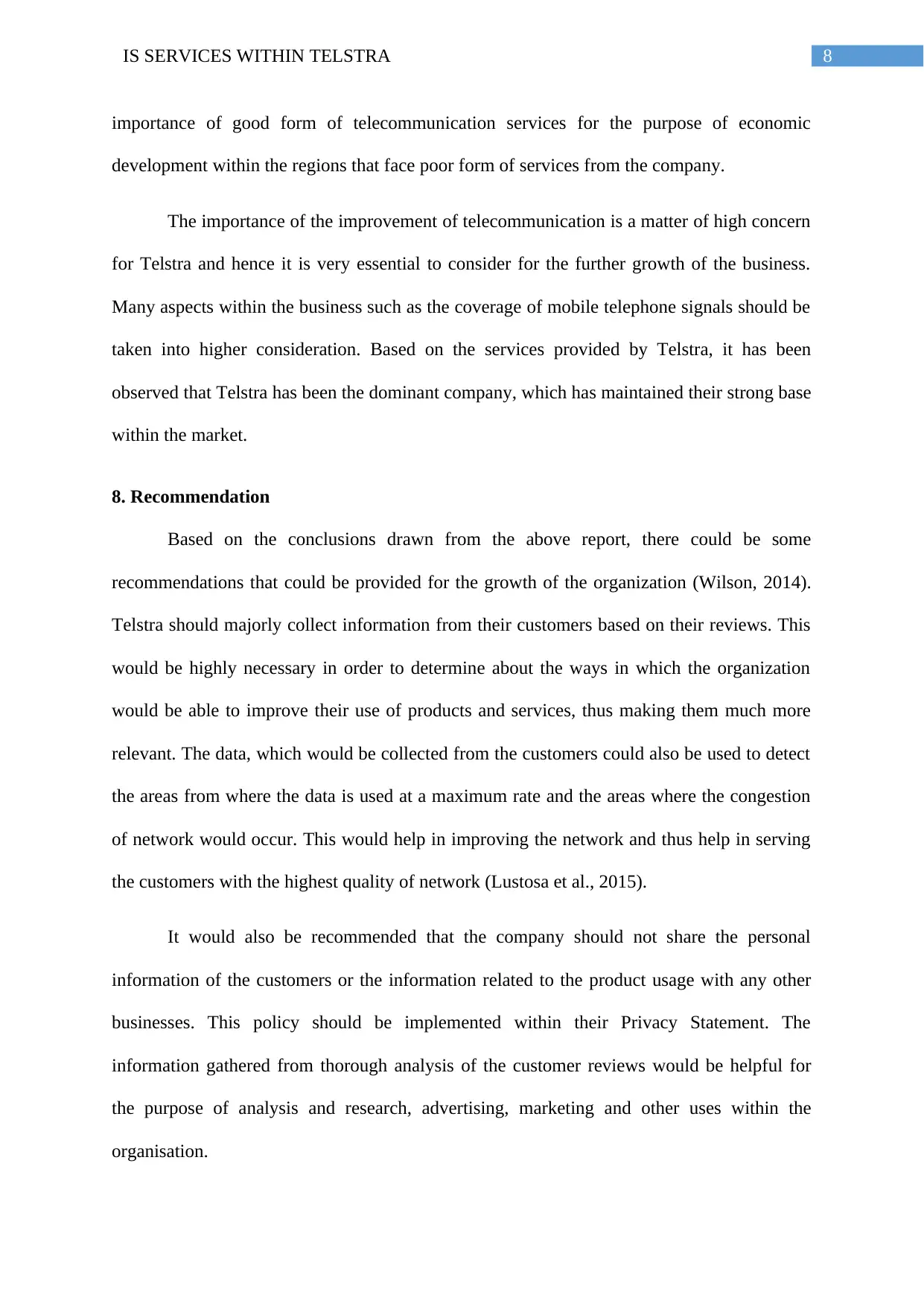
8IS SERVICES WITHIN TELSTRA
importance of good form of telecommunication services for the purpose of economic
development within the regions that face poor form of services from the company.
The importance of the improvement of telecommunication is a matter of high concern
for Telstra and hence it is very essential to consider for the further growth of the business.
Many aspects within the business such as the coverage of mobile telephone signals should be
taken into higher consideration. Based on the services provided by Telstra, it has been
observed that Telstra has been the dominant company, which has maintained their strong base
within the market.
8. Recommendation
Based on the conclusions drawn from the above report, there could be some
recommendations that could be provided for the growth of the organization (Wilson, 2014).
Telstra should majorly collect information from their customers based on their reviews. This
would be highly necessary in order to determine about the ways in which the organization
would be able to improve their use of products and services, thus making them much more
relevant. The data, which would be collected from the customers could also be used to detect
the areas from where the data is used at a maximum rate and the areas where the congestion
of network would occur. This would help in improving the network and thus help in serving
the customers with the highest quality of network (Lustosa et al., 2015).
It would also be recommended that the company should not share the personal
information of the customers or the information related to the product usage with any other
businesses. This policy should be implemented within their Privacy Statement. The
information gathered from thorough analysis of the customer reviews would be helpful for
the purpose of analysis and research, advertising, marketing and other uses within the
organisation.
importance of good form of telecommunication services for the purpose of economic
development within the regions that face poor form of services from the company.
The importance of the improvement of telecommunication is a matter of high concern
for Telstra and hence it is very essential to consider for the further growth of the business.
Many aspects within the business such as the coverage of mobile telephone signals should be
taken into higher consideration. Based on the services provided by Telstra, it has been
observed that Telstra has been the dominant company, which has maintained their strong base
within the market.
8. Recommendation
Based on the conclusions drawn from the above report, there could be some
recommendations that could be provided for the growth of the organization (Wilson, 2014).
Telstra should majorly collect information from their customers based on their reviews. This
would be highly necessary in order to determine about the ways in which the organization
would be able to improve their use of products and services, thus making them much more
relevant. The data, which would be collected from the customers could also be used to detect
the areas from where the data is used at a maximum rate and the areas where the congestion
of network would occur. This would help in improving the network and thus help in serving
the customers with the highest quality of network (Lustosa et al., 2015).
It would also be recommended that the company should not share the personal
information of the customers or the information related to the product usage with any other
businesses. This policy should be implemented within their Privacy Statement. The
information gathered from thorough analysis of the customer reviews would be helpful for
the purpose of analysis and research, advertising, marketing and other uses within the
organisation.

9IS SERVICES WITHIN TELSTRA
Secure Best Marks with AI Grader
Need help grading? Try our AI Grader for instant feedback on your assignments.
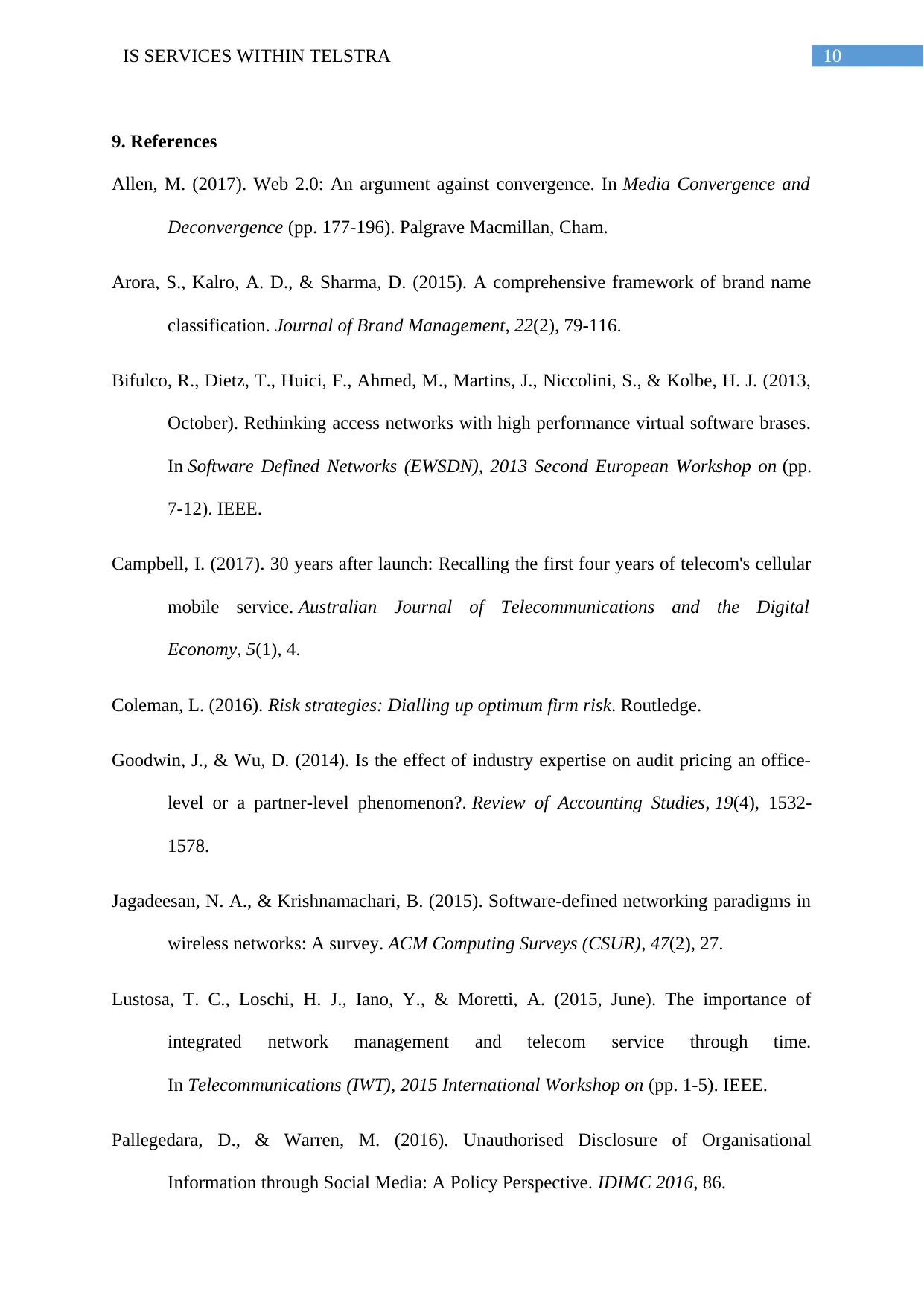
10IS SERVICES WITHIN TELSTRA
9. References
Allen, M. (2017). Web 2.0: An argument against convergence. In Media Convergence and
Deconvergence (pp. 177-196). Palgrave Macmillan, Cham.
Arora, S., Kalro, A. D., & Sharma, D. (2015). A comprehensive framework of brand name
classification. Journal of Brand Management, 22(2), 79-116.
Bifulco, R., Dietz, T., Huici, F., Ahmed, M., Martins, J., Niccolini, S., & Kolbe, H. J. (2013,
October). Rethinking access networks with high performance virtual software brases.
In Software Defined Networks (EWSDN), 2013 Second European Workshop on (pp.
7-12). IEEE.
Campbell, I. (2017). 30 years after launch: Recalling the first four years of telecom's cellular
mobile service. Australian Journal of Telecommunications and the Digital
Economy, 5(1), 4.
Coleman, L. (2016). Risk strategies: Dialling up optimum firm risk. Routledge.
Goodwin, J., & Wu, D. (2014). Is the effect of industry expertise on audit pricing an office-
level or a partner-level phenomenon?. Review of Accounting Studies, 19(4), 1532-
1578.
Jagadeesan, N. A., & Krishnamachari, B. (2015). Software-defined networking paradigms in
wireless networks: A survey. ACM Computing Surveys (CSUR), 47(2), 27.
Lustosa, T. C., Loschi, H. J., Iano, Y., & Moretti, A. (2015, June). The importance of
integrated network management and telecom service through time.
In Telecommunications (IWT), 2015 International Workshop on (pp. 1-5). IEEE.
Pallegedara, D., & Warren, M. (2016). Unauthorised Disclosure of Organisational
Information through Social Media: A Policy Perspective. IDIMC 2016, 86.
9. References
Allen, M. (2017). Web 2.0: An argument against convergence. In Media Convergence and
Deconvergence (pp. 177-196). Palgrave Macmillan, Cham.
Arora, S., Kalro, A. D., & Sharma, D. (2015). A comprehensive framework of brand name
classification. Journal of Brand Management, 22(2), 79-116.
Bifulco, R., Dietz, T., Huici, F., Ahmed, M., Martins, J., Niccolini, S., & Kolbe, H. J. (2013,
October). Rethinking access networks with high performance virtual software brases.
In Software Defined Networks (EWSDN), 2013 Second European Workshop on (pp.
7-12). IEEE.
Campbell, I. (2017). 30 years after launch: Recalling the first four years of telecom's cellular
mobile service. Australian Journal of Telecommunications and the Digital
Economy, 5(1), 4.
Coleman, L. (2016). Risk strategies: Dialling up optimum firm risk. Routledge.
Goodwin, J., & Wu, D. (2014). Is the effect of industry expertise on audit pricing an office-
level or a partner-level phenomenon?. Review of Accounting Studies, 19(4), 1532-
1578.
Jagadeesan, N. A., & Krishnamachari, B. (2015). Software-defined networking paradigms in
wireless networks: A survey. ACM Computing Surveys (CSUR), 47(2), 27.
Lustosa, T. C., Loschi, H. J., Iano, Y., & Moretti, A. (2015, June). The importance of
integrated network management and telecom service through time.
In Telecommunications (IWT), 2015 International Workshop on (pp. 1-5). IEEE.
Pallegedara, D., & Warren, M. (2016). Unauthorised Disclosure of Organisational
Information through Social Media: A Policy Perspective. IDIMC 2016, 86.
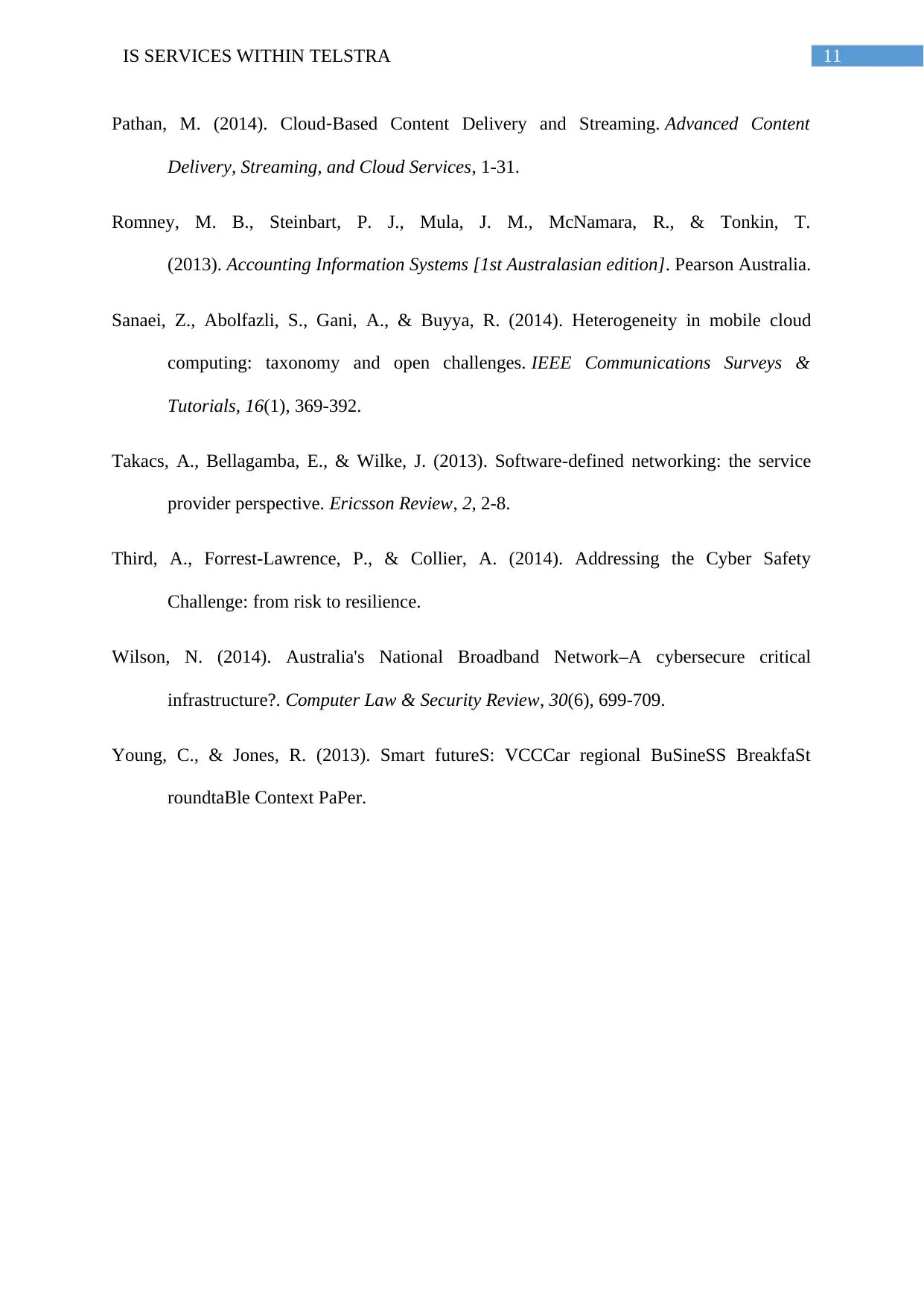
11IS SERVICES WITHIN TELSTRA
Pathan, M. (2014). Cloud‐Based Content Delivery and Streaming. Advanced Content
Delivery, Streaming, and Cloud Services, 1-31.
Romney, M. B., Steinbart, P. J., Mula, J. M., McNamara, R., & Tonkin, T.
(2013). Accounting Information Systems [1st Australasian edition]. Pearson Australia.
Sanaei, Z., Abolfazli, S., Gani, A., & Buyya, R. (2014). Heterogeneity in mobile cloud
computing: taxonomy and open challenges. IEEE Communications Surveys &
Tutorials, 16(1), 369-392.
Takacs, A., Bellagamba, E., & Wilke, J. (2013). Software-defined networking: the service
provider perspective. Ericsson Review, 2, 2-8.
Third, A., Forrest-Lawrence, P., & Collier, A. (2014). Addressing the Cyber Safety
Challenge: from risk to resilience.
Wilson, N. (2014). Australia's National Broadband Network–A cybersecure critical
infrastructure?. Computer Law & Security Review, 30(6), 699-709.
Young, C., & Jones, R. (2013). Smart futureS: VCCCar regional BuSineSS BreakfaSt
roundtaBle Context PaPer.
Pathan, M. (2014). Cloud‐Based Content Delivery and Streaming. Advanced Content
Delivery, Streaming, and Cloud Services, 1-31.
Romney, M. B., Steinbart, P. J., Mula, J. M., McNamara, R., & Tonkin, T.
(2013). Accounting Information Systems [1st Australasian edition]. Pearson Australia.
Sanaei, Z., Abolfazli, S., Gani, A., & Buyya, R. (2014). Heterogeneity in mobile cloud
computing: taxonomy and open challenges. IEEE Communications Surveys &
Tutorials, 16(1), 369-392.
Takacs, A., Bellagamba, E., & Wilke, J. (2013). Software-defined networking: the service
provider perspective. Ericsson Review, 2, 2-8.
Third, A., Forrest-Lawrence, P., & Collier, A. (2014). Addressing the Cyber Safety
Challenge: from risk to resilience.
Wilson, N. (2014). Australia's National Broadband Network–A cybersecure critical
infrastructure?. Computer Law & Security Review, 30(6), 699-709.
Young, C., & Jones, R. (2013). Smart futureS: VCCCar regional BuSineSS BreakfaSt
roundtaBle Context PaPer.
1 out of 12
Related Documents
Your All-in-One AI-Powered Toolkit for Academic Success.
+13062052269
info@desklib.com
Available 24*7 on WhatsApp / Email
![[object Object]](/_next/static/media/star-bottom.7253800d.svg)
Unlock your academic potential
© 2024 | Zucol Services PVT LTD | All rights reserved.



